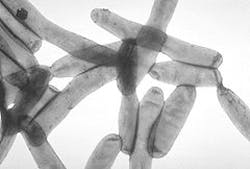Eliminating Legionella contamination of dental waterlines would protect patients, practitioners
By Charles John Palenik, MS, PhD, MBA
This information was brought to you by the Organization for Safety, Asepsis and Prevention (OSAP). OSAP offers dental hygienists information, resources and answers to infection control challenges. Dental hygienists are encouraged to join OSAP to obtain the maximum support available to help ensure the safe and infection-free delivery of oral healthcare. Please visit www.OSAP.org for details.
This information was brought to you by the Organization for Safety, Asepsis and Prevention (OSAP). OSAP offers dental hygienists information, resources and answers to infection control challenges. Dental hygienists are encouraged to join OSAP to obtain the maximum support available to help ensure the safe and infection-free delivery of oral healthcare. Please visit www.OSAP.org for details.
Legionella pneumophila commonly causes healthcare-associated (acute and long-term care facilities) pneumonia and is most often associated with sporadic outbreaks.(1,2) Legionella organisms are aerobic gram-negative fastidious bacteria that do not grow on standard bacteriologic media. Special laboratory culturing methods are required. The Centers for Disease Control and Prevention (CDC) estimates that 8,000-18,000 hospitalized cases of Legionella infection occur annually. The true incidence of disease is not available because of underutilization of diagnostic testing and under-reporting. It is estimated that only 10% of cases are diagnosed.(1,2) Healthcare transmission is firmly linked to drinking water distribution systems, which provide favorable water temperatures, physical protection within biofilms, and nutrients to promote growth. Infection rates depend on contamination levels and the susceptibility of the patient population. Common risk factors include immunosuppression, advanced age (>50), male gender, cigarette smoking, alcohol abuse, transplant recipients, corticosteroid usage, renal failure and chronic pulmonary disease.(1-4) Incidence of healthcare-associated infection depends on the degree of Legionella contamination of the drinking water system and the susceptibility of the patient population to infection.(2-3) Aspiration (e.g., intubation, general anesthesia surgery and nasogastric tubes) is a major route of transmission. Person-to-person transmission does not occur. Aerosolization (e.g., humidifiers and nebulizers), aspiration, and instillation directly into the lung during respiratory tract manipulation have also been linked.(2,5,6)
Legionella species can cause pneumonia (Legionnaires’ disease) and Pontiac fever, a flu-like illness. The species most commonly associated with disease is L. pneumophila. There are numerous serogroups; however, most infections in healthcare facilities are caused by L. pneumophila serogroups 1, 4, and 6.(1,2) In February 2011, an 82-year old woman in Italy was admitted to a local hospital’s intensive care unit with a fever and respiratory stress without an underlying disease.(7) A diagnosis of Legionnaires’ disease was quickly made. Treatment (oral ciprofloxacin) was started immediately. However, the patient developed a fulminant infection and irreversible septic shock and died two days after entering the hospital. An investigation of the source of infection followed. During the usual incubation period (2-10 days) the women had no obvious exposure risks. The only time she left her home was to attend two dental appointments. Water specimens were obtained from the women’s home taps and shower as well as the dental office’s cold water tap, high speed handpiece service lines and three-way syringes. All home specimens were negative for Legionella, while all those of the office were positive. Office isolates were then compared to those of the patient. All were L. pneumophilia from the same highly virulent subgroup 1. After environmental sampling was complete, the office waterlines underwent disinfection with 12% hydrogen peroxide followed by a shock chlorination treatment. This controlled the L. pneumophilia contamination. No other cases of Legionnaires disease or Pontiac fever were noted among the office’s staff or other patients. L. pneumophilia contamination of dental unit waterlines is well documented.(8,9) Also, dental personnel have a higher prevalence of antibodies to L. pneumophilia.(10) This suggests increased occupational risk. However, until the announcement of the Italian case, there had been no reported cases associated with dental unit waterline emissions generated during routine treatment. Public health officials indicated that aerosolized water from high speed handpieces was the likely source of infection. Eliminating Legionella contamination of dental waterlines would protect both patients and practitioners. A number of control measures have been suggested. These include: 1) continuous circulation water systems; 2) using sterile water not only for surgical procedures, but also routine dental treatment; 3) flushing lines between patients; 4) continuous or regularly scheduled disinfection schemes, including handpieces, three-way syringes and power scalers; 5) use of waterline filters and 6) regular testing of water quality.(7,11,12)
References
1. Centers for Disease Control and Prevention. Top 10 Things Every Clinician Needs to Know About Legionellosis. Available at: www.cdc.gov/legionella/top10.htm. Accessed: March 2012.2. Goetz AM, Yu VL - Chapter 77 – Legionella pneumophila. In: Carrico R. APIC Text Online 2011. Available at: text.apic.org/item-81/chapter-77-legionella-pneumophila. Accessed: March 2012.3. Zuckerman JM. Prevention of health care-acquired pneumonia and transmission of Mycobacterium tuberculosis in health care settings. Infect Dis Clin North Am. 25:117-133, 2011.4. Buchholz U, Stocker P, Brodhun B. Legionnaires disease— reordered. Infect Control Hosp Epidemiol. 31: 104–105, 2010.5. Muder RR, Yu VL, Woo A. Mode of transmission of Legionella pneumophila: a critical review. Arch Intern Med 146:1607–1612, 1986.6. Hosein IK, Hill DW, Tan TY, Butchart EG, Wilson K, Finlay G, Burge S, Ribeiro CD. Point-of-care controls for nosocomial legionellosis combined with chlorine dioxide potable water decontamination: a two-year survey at a Welsh teaching hospital. J Hosp Infect 61:100–106, 2005.7. Ricci ML, Fontana S, Pinci F, Fiumana E, Pedna MF, Farolfi P, Bucci Sabattini MA, Scaturro M. . Pneumonia associated with a dental unit waterline. Lancet 379:684, 2012.8. Pankhurst CL, Coulter WA. Do contaminated dental unit waterlines pose a risk of infection? J Dent 35:712-720, 2007.9. Singh T, Coogan MM. Isolation of pathogenic Legionella species and legionella-laden amoebae in dental unit waterlines. J Hosp Infect 61:257-262, 2005.10. Szymanska J. Risk of exposure to Legionella in dental practice. Ann Agric Environ Med 2004; 11: 9–12.11. Organization for Safety, Asepsis and Prevention. From Policy to Practice: OSAP’s Guide to the Guidelines, 2003, OSAP, Annapolis, MD, pp. 75-82.12. Centers for Disease Control and Prevention. Guidelines for Infection Control in Dental Health-Care Settings — 2003. MMWR 52 (RR-17):1-68, 2003.
1. Centers for Disease Control and Prevention. Top 10 Things Every Clinician Needs to Know About Legionellosis. Available at: www.cdc.gov/legionella/top10.htm. Accessed: March 2012.2. Goetz AM, Yu VL - Chapter 77 – Legionella pneumophila. In: Carrico R. APIC Text Online 2011. Available at: text.apic.org/item-81/chapter-77-legionella-pneumophila. Accessed: March 2012.3. Zuckerman JM. Prevention of health care-acquired pneumonia and transmission of Mycobacterium tuberculosis in health care settings. Infect Dis Clin North Am. 25:117-133, 2011.4. Buchholz U, Stocker P, Brodhun B. Legionnaires disease— reordered. Infect Control Hosp Epidemiol. 31: 104–105, 2010.5. Muder RR, Yu VL, Woo A. Mode of transmission of Legionella pneumophila: a critical review. Arch Intern Med 146:1607–1612, 1986.6. Hosein IK, Hill DW, Tan TY, Butchart EG, Wilson K, Finlay G, Burge S, Ribeiro CD. Point-of-care controls for nosocomial legionellosis combined with chlorine dioxide potable water decontamination: a two-year survey at a Welsh teaching hospital. J Hosp Infect 61:100–106, 2005.7. Ricci ML, Fontana S, Pinci F, Fiumana E, Pedna MF, Farolfi P, Bucci Sabattini MA, Scaturro M. . Pneumonia associated with a dental unit waterline. Lancet 379:684, 2012.8. Pankhurst CL, Coulter WA. Do contaminated dental unit waterlines pose a risk of infection? J Dent 35:712-720, 2007.9. Singh T, Coogan MM. Isolation of pathogenic Legionella species and legionella-laden amoebae in dental unit waterlines. J Hosp Infect 61:257-262, 2005.10. Szymanska J. Risk of exposure to Legionella in dental practice. Ann Agric Environ Med 2004; 11: 9–12.11. Organization for Safety, Asepsis and Prevention. From Policy to Practice: OSAP’s Guide to the Guidelines, 2003, OSAP, Annapolis, MD, pp. 75-82.12. Centers for Disease Control and Prevention. Guidelines for Infection Control in Dental Health-Care Settings — 2003. MMWR 52 (RR-17):1-68, 2003.
Charles John Palenik, MS, PhD, MBA, is Director/Scientific Affairs & Research for the Organization for Safety, Asepsis and Prevention.




